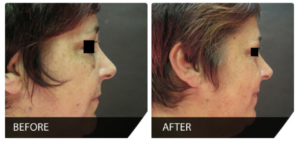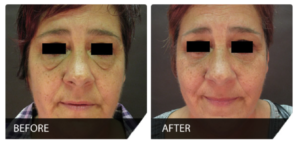Often, the first signs of aging appear around the eyes. Crow’s feet are a major issue for some, but puffy, drooping eyelids can also detract from a patient’s appearance. Fortunately, eyelid surgery, also known as blepharoplasty, can tighten and tone the eyelids, giving you long-lasting results.
What is blepharoplasty surgery?
Blepharoplasty surgery, often known as eyelid reduction surgery, is a plastic surgery procedure that provides an eyelid lift. An upper-eyelid reduction can help you see better and look younger. Wrinkles and puffiness can be reduced with a lower-eyelid reduction.
Types of eyelid procedures
Over time, the skin around your upper or lower eyelids may loosen and puff up. We can treat these issues with a variety of techniques that will leave your eyes looking awake and refreshed.
Upper eyelid surgery
Your upper eyelids are prone to becoming droopy and loose as your skin ages and weakens. Your eyelids may hinder your eyesight if the problem is severe. Furthermore, this change may make you appear sad and fatigued. With an upper eyelid blepharoplasty, we can rejuvenate this area of your face while also improving your vision.
We will make tiny incisions into the folds of your top eyelids during this procedure. These little incisions will be used to remove excess skin and fat from this area of your face. You will appear relaxed, bright, and alert once your eyelids have healed from your top lid blepharoplasty. If your eyelids were obstructing your vision, this treatment could help you.
Lower eyelid surgery
You may also get bags under your eyes in addition to sagging eyelids. You may appear fatigued or sad when you are truly feeling energized and happy if you have this aesthetic problem.
We can correct this with a lower eyelid procedure using a transconjunctival approach. We will make extremely little incisions on the inner part of your lower eyelids during this procedure. We will be able to remove undesirable materials from your eyelid area with this surgery without leaving visible scars on your face.
Combining procedures
It is common to experience aesthetic concerns with your upper and lower eyelids. We may be able to minimize your puffy eyes and droopy upper lids in a single appointment. When you come in for your initial consultation, we can tell you more about the advantages of having numerous eyelid procedures done at the same time.
How long does a blepharoplasty last?
Nothing lasts forever. Nonetheless, blepharoplasty offers some of the most long-lasting outcomes of any plastic surgery procedure—so much so that once you’ve had one, you’re unlikely to need another.
This isn’t to imply that once you’ve recovered from your blepharoplasty, your eyelids will stay the same for the rest of your life. While plastic surgery can help you look younger, it can’t stop you from ageing, and your face will evolve over time.
This means that the alterations performed during your eyelid surgery should be permanent in most cases. Any fat removed from the eyelids, for example, will not return (even if you gain weight). Similarly, bags beneath the eyes and hoods over the eyes should not return. As time goes on, there is a possibility that the brow may descend, causing additional folds on the upper eyelids, although this is usually addressed with a face or brow lift rather than blepharoplasty.
Many specialists claim that blepharoplasty has a shelf life of 10 to fifteen years, but this is not a hard-and-fast rule. Some retouching may be required in the future, but most individuals who get blepharoplasty only need it once—especially if they go to a reputable surgeon who does it right the first time around!
Does blepharoplasty make you look younger?
This operation opens up the eyes and rejuvenates your appearance by tightening the skin on and around the eyelids. It can improve the appearance of the eyelids by removing puffiness and drooping. Blepharoplasty can also remove skin that hangs over the upper eyelid and obscures the upper crease of the eye or obstructs the lashes.
If you’ve grown bags of fat behind your eyes, this procedure can assist with that as well. This produces perfectly natural results, so you won’t have to worry about looking like you’ve just had a cosmetic procedure.
Understanding how a blepharoplasty works
This procedure is done as an outpatient procedure under anesthesia or sedation. We’ll create small incisions in the crease above the eye or just below the lower lash line, depending on whether you’re having your upper or lower eyelids corrected. After that, any excess fat or tissue that is contributing to puffiness is removed, and the skin on the lid is tightened.
Blepharoplasty before and after


What instructions should I follow before my procedure?
Before your visit, we will provide you with a full list of instructions to follow. These instructions will differ based on the sort of eyelid treatment you’re getting, the type of anesthetic you’ll be given, and other factors.
Supplementing your diet
We might suggest that you begin taking Bromelain or Arnica Montana. These homeopathic remedies will help your tissues recuperate faster. You may need to avoid aspirin and other blood thinners for seven to ten days before your surgery in addition to taking these supplements.
Getting ready for your recuperation
During your healing process, we may advise you to take certain medicines. Before your eyelid operation, you should make sure to fill this prescription. You may need to set up a healing space in your home in addition to filling your prescription. On the day before your treatment, we may also tell you to stop drinking and eating by a specific time.
What will happen during my eyelid procedure?
Before the procedure
Anesthesia will be used to keep you comfortable while we work on your eyelids. You may undergo local anesthesia with intravenous sedation, depending on your preferences and needs. Alternatively, we can administer a general anesthetic.
During the procedure
Once the anesthesia is administered, we’ll start improving the tissues around your eyes. The placement of the incisions will be determined by the type of eyelid surgery you chose. We shall make little incisions in the folds of your lids if you want to improve your upper eyelids.
We will most likely make incisions in the interior of your lower eyelids if we are repairing your lower lids. We will be removing fat, undesirable skin, and other tissues from your body through the incisions. Sutures may be used to close your incisions once we have removed these components.
Will my eyelids take a long time to recover?
You will only have a short recovery period because this is an outpatient treatment. You’ll need to change your exercise routines, screen time, and bathing habits during this period. Making these small adjustments to your daily routine can help preserve your eyes and tissues as they recuperate.
Protect your eyes
During the first few weeks of your recovery, it’s critical to look after your eyes. During your healing phase, we will supply you with antibiotics. This drug must be taken for one week. You may also need to use artificial teardrops to keep your eyes from drying out.
We may advise you to apply a cold compress or ice packs to your face for the first several days. We may also recommend that you sleep with your face elevated. You can prop up your head using cushions to keep your face in the proper position. Fluid will be less likely to build in your tissues if you raise your head during the night.
Bathing and Showering
After your surgery, you should be able to resume bathing and showering within a few days. You should avoid getting your eyes wet while bathing or showering to ensure your safety. Move your showerhead below your face to achieve this. You can also enlist the help of a friend or family member to wash your hair in the sink.
We will most likely remove your sutures after seven to ten days. You should be able to start cleansing the skin surrounding your eyes at this point. When cleaning this part of your face, you should be very careful.
Resting your eyes and body
Your eyes can become dry and irritated if you spend too much time staring at a computer, smartphone, or other screen. You should minimize your screen time during the first few weeks after your treatment to avoid this problem.
You should not go swimming or running for the first two weeks after your surgery. You must also refrain from indulging in other sorts of strenuous physical activity. In addition, we suggest that you refrain from bending your body excessively or placing your head beneath your heart. Boosting blood flow to the tissues around your eyes can slow down the healing process.
Help your skin
It’s natural for scabs to form during the healing process. A scab is an indication that your tissues are healing, and it’s a good sign. Rather than picking at your scabs, try to leave them alone. Once your tissues have recovered, your scabs will come off.
Contacts and Makeup
If you wear contacts to correct your vision, you must refrain from using them for three to four weeks following your treatment. For roughly three weeks, you should avoid applying makeup around your eyes. When you resume wearing mascara and other types of eye makeup, you should use new makeup products and applicators to avoid infection.
Am I a good candidate for an eyelid procedure?
You’re unhappy with your eyelids
Eyelid surgery may be the solution if you’re bothered by sagging eyelids or bags beneath your eyes. Many of our patients have tried serums and eye lotions with limited success and are now able to get their desired outcomes with eyelid surgery.
You’re prepared to invest in your physical appearance
The treatments we offer for the eye area are not usually covered by insurance unless they are undertaken to correct your vision or for some other medical reason. Candidates for eyelid surgery typically see the procedure as an investment in themselves.
You’re healthy
It helps if you’re in generally good health and don’t have any major underlying health issues.
You’re aware of the possible outcomes
Candidates for this operation should be emotionally stable, comprehend the procedure, and have realistic expectations for the outcomes. This procedure will not remove decades from your appearance, but it will restore the natural shape of your eyes and improve the proportions of your face.
What is the first step?
The first step in determining whether you are a good candidate for eyelid surgery is to schedule an initial consultation with our board certified surgeons. This visit will be used to discuss the treatment in greater detail. We’ll also go over your medical history, examine your face, and see if this procedure gives you the blepharoplasty results you want. After that, all you have to do is schedule your operation.
